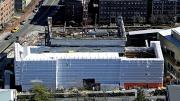Even the heaviest of heavy construction can seem like precision watchmaking. Take the reconstruction of the Fogg Art Museum.
It began in early 2010 by removing much of the original structure beyond the Quincy Street façade, then propping up what remained while excavating deep underground to create new spaces. That required shoehorning massive concrete pumps onto the narrow site (hemmed in by Quincy and Prescott streets, Broadway, and the swooping Carpenter Center ramp) to drop tons of slurry, just so, into forms far below. During this mild winter, an enormous crane was anchored to the new subterranean structure; it finally began lifting the steel girders into place for the new structure that will rise within, around, and over the skeletal Fogg—a rebirth, timed to the early arrival of spring in New England. (Harvard Art Museums documents the project’s progression in a stunning set of elevated and aerial photographs taken through the changing seasons; see https://tiny.cc/dhbubw).
As this multihundred-million-dollar task has proceeded, the Quincy Street façade has been wrapped in white tarps to protect the work and craftsmen within—almost as if Christo had been retained to make the site one of his monumental sculptures. The project, surrounded by the campus and hard by Cambridge Rindge and Latin high school, has been a feast for sidewalk superintendents, as intimate a viewing experience as watching a painter at work in her studio. (And it has been timely for construction fans, given the completion of the Law School’s massive multiuse building; the still-early work on the Business School’s Tata Hall for executive-education students; and the dearth of other Harvard mega-projects in this post-recession era.)
Befitting the nation’s preeminent academic art museum, the reconstruction of the Fogg is a work of art.









